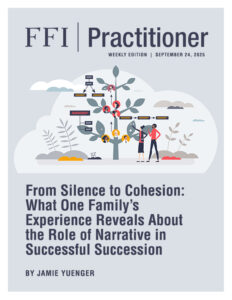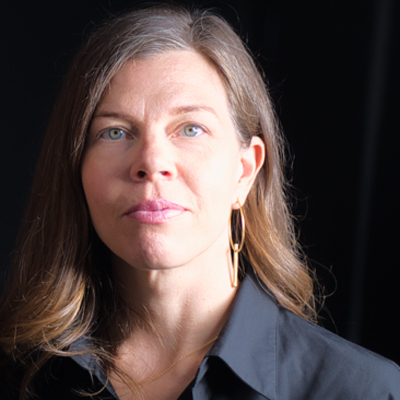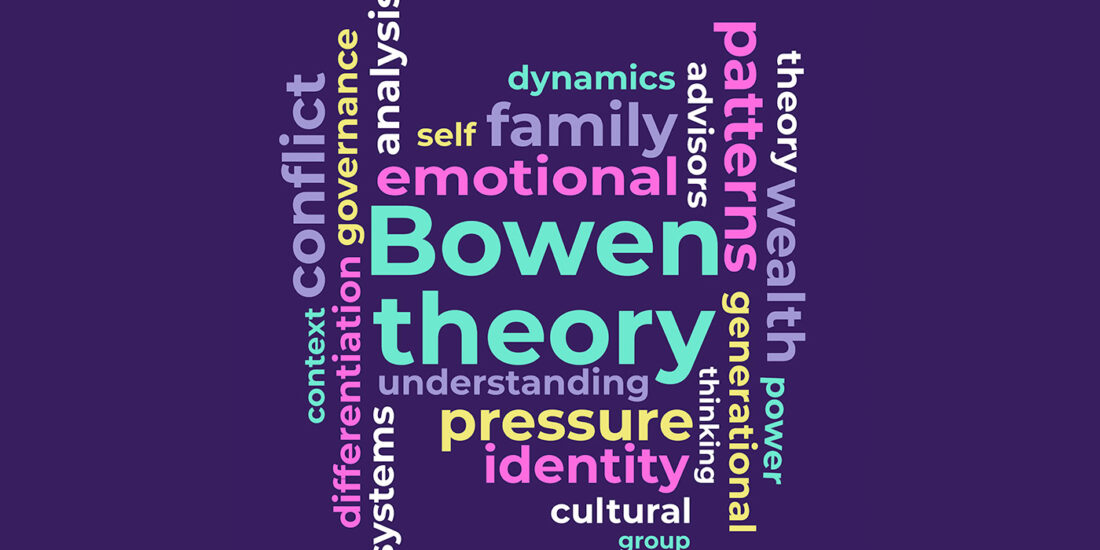
View this edition in our enhanced digital edition format with supporting visual insight and information.
Thank you to Jamie Yuenger, founder of StoryKeep, for this article, which is a companion piece to the FFI Practitioner podcast episode, “The Power of Narrative in Family Businesses: A Conversation with Jamie Yuenger and Lisabeth Sugahara.” This article makes the case that integrating storytelling into succession planning helps families build trust, surface hidden histories, and align around new leadership, ensuring continuity that endures alongside the documents.
Most enterprising families approach succession by working through legal and financial structures, sometimes complemented by governance or leadership planning. These are essential. But they may not address a missing dimension: the family’s story. Who are we as a family? What have we endured together? What do we want to pass on besides assets?
When one of the Sugahara family’s trusted family enterprise advisors encouraged them to document the stories and contributions of their father and uncles during succession planning, her suggestion wasn’t to add another policy or restructure a chart. It was to surface something harder to see but just as critical: the family’s own story, the untold history standing in the way of the continuity they hoped to achieve.
The Sugaharas, owners of the third-generation enterprise Fairfield-Maxwell, decided to capture their history—not just the business story, but the family’s.
At that moment, ownership and leadership were passing from two G2 brothers in their eighties to five G3 cousins across two branches—a sensitive handoff that called for more than documents alone. What began as a project to honor the lives and contributions of the two patriarchs became something larger. All five cousins of the third generation gathered for the first time at their family vacation home, where StoryKeep interviewed each of them about their shared narrative inheritance and their vision for the future. They cheered each other on as they spoke and, in the process, discovered they were doing something remarkable: collectively telling their family story in a cohesive way for themselves and for their children, nieces, and nephews. A film ultimately captured this work—including the long-silenced story of the family’s internment during World War II—but the true impact came from the storytelling process itself.
This article makes the case that storytelling is not a soft extra, but a missing—and essential—dimension in continuity planning. Advisors who bring narrative to the fore help families care for not just assets, but also identity, belonging, and cohesion.
The Missing Dimension
Succession planning usually emphasizes structure: who owns what, how decisions will be made, what tax or legal tools will protect wealth. But documents alone don’t answer the deeper questions: Why does this enterprise—and this family—matter? What values hold us together?
Decades of research back up what families like the Sugaharas discovered in practice. Scholars such as Robyn Fivush (Emory University)1 and Jody Koenig Kellas (University of Nebraska–Lincoln)2 have shown that family stories actively shape identity, belonging, and resilience across generations. Families that tell stories highlighting care, togetherness, humor, and adaptability report higher satisfaction and well-being.
As Betsy Sugahara, one of the five G3 cousins, observed: “We were always focusing on the business. And I think focusing on the family … really made us understand that something we’d been trying to say for years was not coming across.”3
Without story, families may repeat messages like “we’re more than a business,” but until they hear and share each other’s experiences, the meaning doesn’t take hold.
When Silence Meets Succession
The Sugahara family entered their storytelling work at a hinge moment: ownership and leadership were passing from G2 to G3. One of the five cousins was being put forward as the next CEO. But for that transition to hold, he needed not only the legal approval of his cousins but also their emotional backing—trust that he could carry the family’s story and vision forward.
The five cousins gathered for the first time to be interviewed. They weren’t only recounting business milestones; they were making sense of a shared inheritance and what it should mean for the next generation. The setup mattered: being present together, across branches, invited candor and connection the family hadn’t experienced in quite this way before.
Here’s some context. During World War II, the U.S. government forcibly removed and incarcerated more than 120,000 people of Japanese ancestry. In the Sugahara family, Betsy’s grandparents, father, and uncles were among those interned. Like many families, they rarely spoke about it afterward—silence, for decades, became part of the legacy.
What the storytelling process surfaced was the power of naming what had been unnamed. As Betsy put it: “Some of the things that hadn’t been talked about at all—like the fact that the entire family was interned during World War II— … now people are talking about it very freely and openly.” She noticed a shift in her father in particular: “There is sort of a lightness to him now and a peace. And he talks about it openly.”4
The family was initially hesitant to include the internment story in the film. As their narrative and creative collaborators, StoryKeep told them it might be worth bringing forward. Ultimately, they decided to lean into it—transforming a silenced history into shared resilience and meaning at the exact point of leadership transfer.
Research underscores what unfolded for them: when younger generations hear detailed stories from parents and grandparents, they show stronger identity, competence, and sense of purpose.5 These intergenerational narratives can be more predictive of well-being than personal stories alone. For the Sugaharas, it was more than business succession; it was cohesion of the family that would be doing the succession.
As Betsy also reflected: “Just because you’re not a member of the business does not mean you’re not an important member of the family.”6 Research supports her observation: families that tell stories collaboratively, where multiple perspectives are invited and affirmed, report higher cohesion and adaptability than those where stories are told individually.7
Strengthening Succession & Leadership Transitions
The storytelling process also became the proving ground for the leadership handoff itself. In his filmed interview, the cousin stepping into the CEO role used the opportunity not only to express gratitude and respect for his father and uncles, but also to demonstrate that he could carry forward the family’s evolving vision. His four cousins, in turn, could see and hear themselves in the shared narrative. This made it easier for them to align behind him—not just legally, but emotionally.
As Betsy reflected: “Having all of us do this together makes it easier to … put everyone’s support behind my cousin Chris, who is the next CEO now of the company. It was easier for everyone to get behind the idea of ownership transition. That was definitely a big sticking point for decades, but it happened and it worked.”8
Advisors know that transitions often stall not because the plan is poorly drafted, but because trust is thin. In this case, storytelling created the connective tissue: a context in which the new leader could step forward, and his peers could genuinely stand behind him.
As Betsy put it: “It was the process more than the product. And the process continues. I see the product as sort of a milestone, something that was a takeaway, but it’s the emotion.”9
The end product for the Sugaharas was a film, but what mattered equally was the process: gathering across branches, sharing untold stories, and creating a tangible narrative that future generations could inherit. The film became a milestone, but the storytelling itself was the rite of passage.
Elevating Overlooked Voices
Storytelling also challenges patriarch-only legacies and elevates hidden leadership, often women’s.
Betsy again: “We heard a lot about the strength of the women in the family … My grandmother was the one who said after the camps, ‘we can sit here and try to get our land back … or we can move east and start a new life.’ And she’s the one who picked up the family and moved everybody east.”10
In work as legacy filmmakers, StoryKeep can find that many projects center around the patriarch. But there’s been a wave of families looking at the stories of women and in-laws in their families, not just as supportive to the patriarch but having their own story in their own right.
This reframes “legacy” as multi-voiced, inclusive, and dynamic—a vital ingredient for resilient succession.
Conclusion: Beyond the Documents
Succession is about people. And people are bound up in story. Some say story is what makes us human.
Succession that rests only on documents is brittle. Succession that includes story is resilient.
What’s at stake in succession is not only wealth but also family order, cohesion, and well-being. Without narrative, families risk discord, branch divisions, or even dissolution. With it, they build alignment and resilience.
For advisors, the message is clear. Legal and financial structures are essential, but they are not enough. By making space for narrative—through interviews, workshops, or guided storytelling sessions—advisors can help families secure not just their assets, but their identity, belonging, and trust. That is the true foundation for continuity.
References
1 “Family Storytelling,” Robyn Fivush, accessed August 29, 2025, https://www.robynfivush.com/family-storytelling/.
2 “Jody Koenig Kellas,” University of Nebraska-Lincoln, accessed August 29, 2025, https://comm.unl.edu/person/jody-koenig-kellas/.
3 Jordan Rich, host, FFI Practitioner podcast, “The Power of Narrative in Family Businesses: A Conversation with Jamie Yuenger and Betsy Sugahara,” Family Firm Institute, September 10, 2025, at 8:04–16, https://digital.ffi.org/editions/the-power-of-narrative-in-family-businesses-a-conversation-with-jamie-yuenger-and-lisabeth-sugahara/.
4 Rich, “The Power of Narrative,” at 13:00–19.
5 Robin Fivush et al., “Personal and Intergenerational Narratives in Relation to Adolescents’ Well-Being,” New Directions for Child and Adolescent Development 2011, no. 131 (2011): 45–57. https://doi.org/10.1002/cd.288.
6 Rich, “The Power of Narrative,” at 8:18–23.
7 Jody Koenig Kellas and April R. Trees, “Finding Meaning in Difficult Family Experiences: Interaction Processes During Joint Family Storytelling,” Journal of Family Communication 6, no. 1 (2006): 49–76. https://doi.org/10.1207/s15327698jfc0601_4.
8 Rich, “The Power of Narrative,” at 13:58–14:19.
9 Rich, “The Power of Narrative,” at 18:19–29.
10 Rich, “The Power of Narrative,” at 14:28–51.
About the Contributor

Jamie Yuenger is founder of StoryKeep, which creates private films and podcasts with individuals and families to connect their current and future generations through the power of story. After training as a folklorist, she worked in broadcast journalism, including as assistant producer at WNYC. She can be reached at jamie@storykeep.com.

View this edition in our enhanced digital edition format with supporting visual insight and information.





